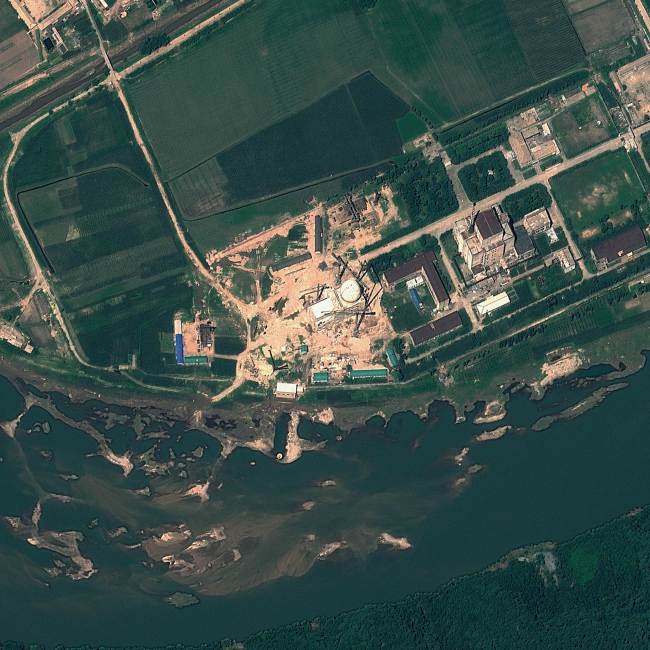Fresh evidence has surfaced to shore up speculation that North Korea has restarted a nuclear reactor to produce plutonium for bombs, a U.S. think tank said Thursday.
Satellite photos from Sept. 19 showed hot waste water being discharged into the nearby Guryong River from a recently installed drainpipe that is part of a new cooling system at the Yongbyon nuclear complex.
This indicates that “the reactor is in operation and the turbine-powered electrical generators are producing power,” said Nick Hansen of the U.S.-Korea Institute at Johns Hopkins School of Advanced International Studies on its website, 38 North.
The findings are the latest in a string of signs that the communist state has put its 5-megawatt graphite-moderated reactor back online, possibly to use as a bargaining chip in disarmament-for-aid negotiations with Washington.
 |
This file satellite image taken on August 6, 2012 and provided by GeoEye on August 22, 2012 shows the Yongbyon Nuclear Scientific Research Centre in North Korea. (AFP) |
In April, Pyongyang announced that it would reactivate the reactor that was shuttered and disabled under a 2007 six-party agreement involving the South, the U.S., China, Japan and Russia. The decision coincided with the North’s adoption of the so-called parallel pursuit of nuclear and economic development.
The Washington-based institute earlier studied satellite imagery from late August which showed steam coming out of a generator building at the complex, suggesting the reactivation process was in full swing. The Institute for Science and International Security said in August that the North had doubled the size of the Yongbyon plant, citing other aerial photos.
The nuclear reactor generates electricity by heating water until it becomes high-pressure steam that in turn is piped to a turbine and spins it, SAIS explained. The steam cools after passing through the turbine and condenses into hot waste water that must be removed from the turbine building. It is pumped into the drainpipe and when the hot water reaches the river bank it produces white foam at the end of the drainpipe.
South Korea has said the moves would constitute “a serious situation” and “breach of past agreements and U.N. Security Council resolutions.”
“If they did restart the reactor, they would probably attempt to use it as another card in future negotiations given repeated offers of dialogue,” a Seoul official said on condition of anonymity due to the sensitivity of the matter.
Established in 1986, the reactor had been used to reprocess spent fuel rods to extract plutonium as the fissile material for Pyongyang’s atomic weapons before its 2008 destruction.
Seoul officials and experts forecast the resumption process would take about a year, which would include reerecting the cooling tower and recovering reprocessing equipment.
If fully restored, reprocessing its some 8,000 fuel rods that are used for one year could yield about 6 kilograms of plutonium, sufficient to make at least one fission bomb a year, they say.
The military-focused regime has staged three nuclear tests since 2006. Analysts predict that it already has enough plutonium for four to eight weapons, albeit crude ones.
After a deluge of warlike threats in the spring, the North has in recent months been seeking reconciliation with its longtime foes, calling alongside China for high-level dialogue with the U.S. and a resumption of the six-party talks that have been on hold for five years.
But Seoul and Washington remain steadfast in their demand that Pyongyang should first prove its sincerity with action.
At the U.N. General Assembly, North Korean Vice Foreign Minister Pak Kil-yon again called on Washington to scrap its “hostile policy” and return to the negotiating table.
“(The North) remains consistent in its stand and effort to put an end to the tension on the Korean Peninsula by peaceful means through dialogue and negotiations, and contribute to ensuring peace and security in the region,” he said Tuesday.
A senior U.S. State Department official said Wednesday there is a “strong agreement” between Seoul, Washington and Tokyo that “we don’t want talks for talks’ sake” and stressed the importance of Pyongyang “demonstrating through its actions that there is more to talks than just empty promises.”
The official was speaking en route to Tokyo with Secretary of State John Kerry, who is scheduled for the so-called two-plus-two meeting on Thursday with U.S. Secretary of Defense Chuck Hagel and their respective Japanese counterparts, Fumio Kishida and Itsunori Onodera.
Kerry and Kishida will confer on “what that means in terms of specific steps” and “what more we need in terms of both cooperation from China in on the pressure track and what we would consider a credible threshold for North Korea on the diplomatic track,” the official said on condition of anonymity due to the sensitivity of the issue.
By Shin Hyon-hee
(
heeshin@heraldcorp.com)








